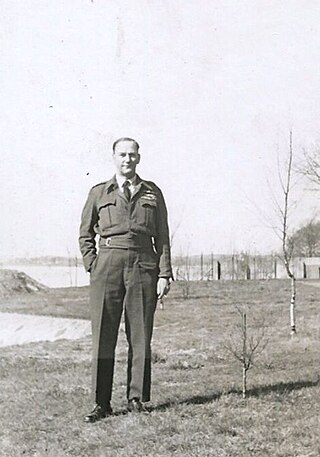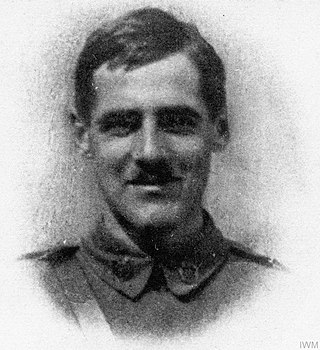Related Research Articles
Captain Hazel LeRoy Wallace DFC was a Canadian First World War flying ace, officially credited with 14 victories. His record shows him to have been a notable team player in squadron tactics.
Sergeant William Joseph Benger was a British First World War flying ace credited with five aerial victories over German Albatros D.V fighters.
Robert Samuel Herring was a British officer who served in the Army and the Royal Air Force in both World Wars. In World War I he became a flying ace, and spent most of World War II as a prisoner of the Japanese.
Lieutenant Thomas Archibald Mitford Stuart Lewis was a British World War I flying ace credited with six aerial victories.
Flight Lieutenant William Geoffrey Meggitt was a British World War I flying ace credited with six aerial victories.

Air Vice Marshal Thomas Cathcart Traill, was a senior Royal Air Force officer. He began his military career as a midshipman in the Royal Navy, transferred to the Royal Flying Corps in 1917 and rose to the rank of captain during the First World War, becoming a flying ace credited with eight aerial victories. He remained in the newly formed Royal Air Force after the war; by the time he retired in 1954, he had risen to the rank of air vice marshal.
Sergeant Ernest Arthur Deighton was an English World War I observer/gunner flying ace credited with 15 confirmed aerial victories; all but one of them was against enemy fighters.
Captain Reginald Howard Rusby Distinguished Flying Cross|DFC was a World War I flying ace credited with ten aerial victories.
Captain Charles Stewart Touzeau Lavers BEM was a British World War I flying ace credited with nine aerial victories.
Group Captain Gilbert Ware Murlis Green, was a Royal Air Force career officer credited with eight aerial victories. He was a pioneer among fighter aces, and his victories were scored in a variety of theatres and flying environments. He was successful on both the Western Front, in Greece, and on his home soil. He also commanded two of the original night fighter squadrons.
Group Captain Campbell Alexander Hoy was a British flying ace during the First World War, credited with eleven aerial victories. He remained in the Royal Air Force post-war and served through the end of the Second World War.
Captain Frank Clifton Gorringe was a British World War I flying ace credited with 14 aerial victories.

Captain Noel William Ward Webb was a British World War I flying ace credited with fourteen aerial victories. He also claimed the life of German ace Leutnant Otto Brauneck for his ninth victory.
Captain Reginald Carey Brenton Brading was a British World War I flying ace credited with thirteen confirmed aerial victories.
Captain Stanley Stanger was a World War I flying ace credited with 13 confirmed aerial victories scored on the Italian Front. He was also noted for his ingenious escape from being captured by the Austro-Hungarians.
Walter Naylor, & Bar was the leading observer ace of the Royal Naval Air Service, with 14 accredited victories. He flew as an enlisted observer/gunner in Airco DH.4 bombers in No. 5 Naval Squadron along the English Channel.
Lieutenant Josiah Lewis Morgan was a Welsh flying ace in the Royal Air Force. He was credited with 12 official victories during World War I. He served as an observer/gunner for Hiram Frank Davison for all but one of his victories.
Lieutenant Thomas Montagu Harries was a Scottish World War I flying ace credited with 11 aerial victories. He was the second scoring ace using the Sopwith 1½ Strutter; he then also became an ace on the Royal Aircraft Factory SE.5a.
Lieutenant Clement Wattson Payton was an English World War I flying ace credited with 11 official victories.
Lieutenant Melville Wells Waddington was a World War I Canadian flying ace credited with twelve aerial victories. He was the first observer ace in No. 20 Squadron of the Royal Flying Corps to score a victory in the Bristol Fighter.
References
- ↑ Franks et.al. (1997), pp.6–7.
- 1 2 Franks et.al. (1997), p.6.
- ↑ "No. 29321". The London Gazette (Supplement). 8 October 1915. p. 9991.
- ↑ "No. 29787". The London Gazette (Supplement). 18 October 1916. p. 10029.
- ↑ "No. 30326". The London Gazette (Supplement). 5 October 1917. p. 10370.
- ↑ "No. 30352". The London Gazette (Supplement). 26 October 1917. p. 11011.
- ↑ Franks et.al. (1997)
- ↑ "No. 31632". The London Gazette (Supplement). 7 November 1919. pp. 13546–13547.
- ↑ "No. 31170". The London Gazette (Supplement). 7 February 1919. pp. 2034–2036.